Effects of Pore Size on Fatigue Deformation Mechanism of Open-Cell Copper Foam at Low Stress Amplitude
Abstract
:1. Introduction
2. Experimental
2.1. Material
2.2. Experiment Methods
3. Results and Discussion
3.1. Fatigue Properties
3.2. Microstructure Morphology
4. Conclusions
- (1)
- The fatigue failure mechanism of the open-cell copper foam at low stress amplitude is layer-by-layer collapse. Fatigue damage tend to occur at the defects at the initial stage and the deformed region will merges into a large horizontal deformation area in the middle of the specimen with the increase of fatigue cycles.
- (2)
- An increasing in pore size which is related to a thicker strut will result in a better compression strength as well as longer fatigue life when the specimen was tested at low stress amplitude. The strut thickness (correlated to pore size) is the primary factor affecting the fatigue deformation mechanism which is decisive to the fatigue life of the open-cell copper foam. The scanning electron microscopy results are accordant with the experimental data as smaller pore size is correlated with thinner strut and more defects. Stress concentrations can be easily formed in the weak node and result in the initiation of cracks at the joints of strut which cause a severe damage to specimens by accelerating the collapse of holes.
Author Contributions
Funding
Conflicts of Interest
References
- Mazouzi, D.; Reyter, D.; Gauthier, M. Very high surface capacity observed using Si negative electrodes embedded in copper foam as 3D current collectors. Adv. Energy Mater. 2014, 4, 1079–1098. [Google Scholar] [CrossRef]
- He, Z.Q.; Wang, Q.; Sun, J.J. A silver-modified copper foam electrode for electrochemical dehalogenation using mono-bromoacetic acid as an indicator. Int. J. Electrochem. Sci. 2011, 6, 2932–2942. [Google Scholar]
- Lu, W.; Zhang, T.; Yang, M. Analytical solutions of force convective heat transfer in plate heat exchangers partially filled with metal foams. Int. J. Heat Mass Transf. 2017, 110, 476–481. [Google Scholar] [CrossRef]
- Wu, Z.; Huang, R.R.; Yu, H.; Xie, Y.C.; Lv, X.Y.; Su, J.; Long, Y.F.; Wen, Y.X. Deep eutectic solvent synthesis of LiMnPO4/C nanorods as a cathode material for Lithium Ion Batteries. Materials 2017, 10, 134. [Google Scholar] [CrossRef] [PubMed]
- Martha, S.K.; Dudney, N.J.; Kiggans, J.O.; Nanda, J. Electrochemical stability of carbon fibers compared to metal foils as current collectors for Lithium-Ion Batteries. J. Electrochem. Soc. 2012, 159, A1652–A1658. [Google Scholar] [CrossRef]
- Popovich, A.A.; Maximov, M.Y.; Novikov, P.A. Cyclic stability of the anode material based on tin(IV) oxide for thin-film current sources. Russ. J. Appl. Chem. 2016, 89, 679–681. [Google Scholar] [CrossRef]
- Ren, W.; Cheng, H.M. The global growth of graphene. Nat. Nanotechnol. 2014, 9, 726–730. [Google Scholar] [CrossRef] [PubMed]
- Nam, D.H.; Kim, R.H.; Han, D.W. Electrochemical performances of Sn anode electrodeposited on porous Cu foam for Li-ion batteries. Electrochim. Acta 2004, 49, 126–132. [Google Scholar] [CrossRef]
- Fan, X.Y.; Ke, F.S.; Wei, G.Z. Sn–Co alloy anode using porous Cu as current collector for lithium ion battery. J. Alloys Compd. 2009, 476, 70–73. [Google Scholar] [CrossRef]
- Yang, Y.S.; Zhe, Y.; Kua-Hai, Y.U. Study on the cushioning property and deformation failure mechanism of close-cell aluminum foam. J. Funct. Mater. 2014, 45, 08087–08091. [Google Scholar]
- Zheng, M.J.; He, D.P.; Chen, F. Compressive stress-strain behavior and energy absorption capability of porous aluminum alloy. Chin. J. Nonferrous Met. 2001, 7, 37–49. [Google Scholar]
- Zettl, B.; Mayer, H.; Stanzl-Tschegg, S.E. Fatigue properties of aluminium foams at high numbers of cycles. Mater. Sci. Eng. A 2000, 292, 1–7. [Google Scholar] [CrossRef]
- Stanzl-Tschegg, S.E.; Mayer, H. Fatigue and fatigue crack growth of aluminium alloys at very high numbers of cycles. Int. J. Fatigue 2001, 23, 231–237. [Google Scholar] [CrossRef]
- Ingraham, M.D.; Demaria, C.J.; Issen, K.A. Low cycle fatigue of aluminum foam. Mater. Sci. Eng. A 2009, 504, 150–156. [Google Scholar] [CrossRef]
- Qiang, S.; Xing, Y.M. Experimental research and numerical simulation on melting and solidification of metal foam composite phase change material. J. Funct. Mater. 2013, 221, 99–111. [Google Scholar]
- Mancin, S.; Zilio, C.; Diani, A. Experimental air heat transfer and pressure drop through copper foams. Exp. Therm. Fluid Sci. 2012, 36, 224–232. [Google Scholar] [CrossRef]
- Chen, J.; Li, C.; Zhang, J.; Li, C.; Chen, J.; Ren, Y. First-principles study on the adsorption and dissociation of impurities on copper current collector in electrolyte for Lithium-Ion Batteries. Materials 2018, 11, 1256. [Google Scholar] [CrossRef] [PubMed]
- El-Hadek, M.A.; Kaytbay, S. Mechanical and physical characterization of copper foam. Int. J. Mech. Mater. Des. 2008, 4, 63–69. [Google Scholar] [CrossRef]
- Chen, J.; Li, X.; Li, W.; He, J.; Li, C.; Dai, S.; Chen, J.; Ren, Y. Study on the compression properties and deformation failure mechanism of open-cell copper foam. Adv. Eng. Mater. 2017, 19, 1600861–1600869. [Google Scholar] [CrossRef]
- Dai, S.; Chen, J.; Ren, Y.; Liu, Z.; Chen, J.; Li, C.; Zhang, X.; Zhang, X.; Zeng, T. Electrochemical corrosion behavior of the copper current collector in the electrolyte of Lithium-ion Batteries. Int. J. Electrochem. Sci. 2017, 12, 10589–10598. [Google Scholar] [CrossRef]
- Chen, J.; Li, X.; Li, W.; Li, C.; Xie, B.; Dai, S.; He, J.; Ren, Y. Research on energy absorption properties of open-cell copper foam for current collector of Li-ion. Mater. Sci. Pol. Stage Publ. 2018, in press. [Google Scholar]
- Zhao, C.Y.; Kim, T.; Lu, T.J. Thermal Transport Phenomena in Porvair Metal Foams and Sintered Beds; Final Report; University of Cambridge: Cambridge, UK, August 2001. [Google Scholar]
- Phang, P.; Dollimore, D. An evaluation of the relationship between kinetic data collection of DTG curves and its corresponding R-square and activation energy values for kinetic plots. Thermochim. Acta 2001, 367, 239–251. [Google Scholar] [CrossRef]
- Hossain, M.M.; Shivakumar, K. Compression fatigue performance of a fire resistance syntactic foam. Compos. Struct. 2012, 94, 290–298. [Google Scholar] [CrossRef]
- Fang, Q.; Zhang, J.H.; Zhang, Y.D.; Liu, J.C.; Gong, Z.M. Mesoscopic investigation of closed-cell aluminum foams on energy absorption capability under impact. Compos. Struct. 2015, 124, 409–420. [Google Scholar] [CrossRef]
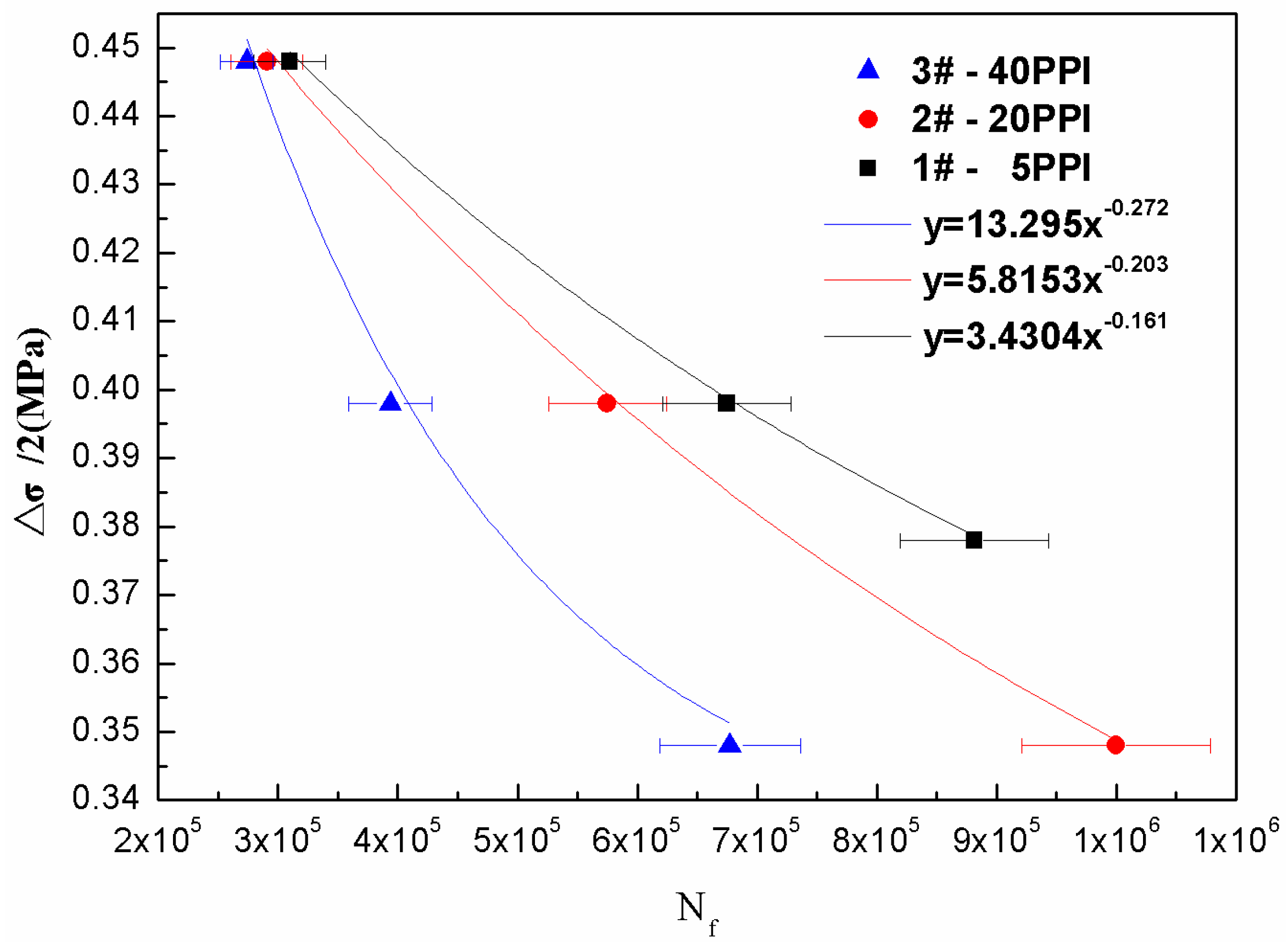
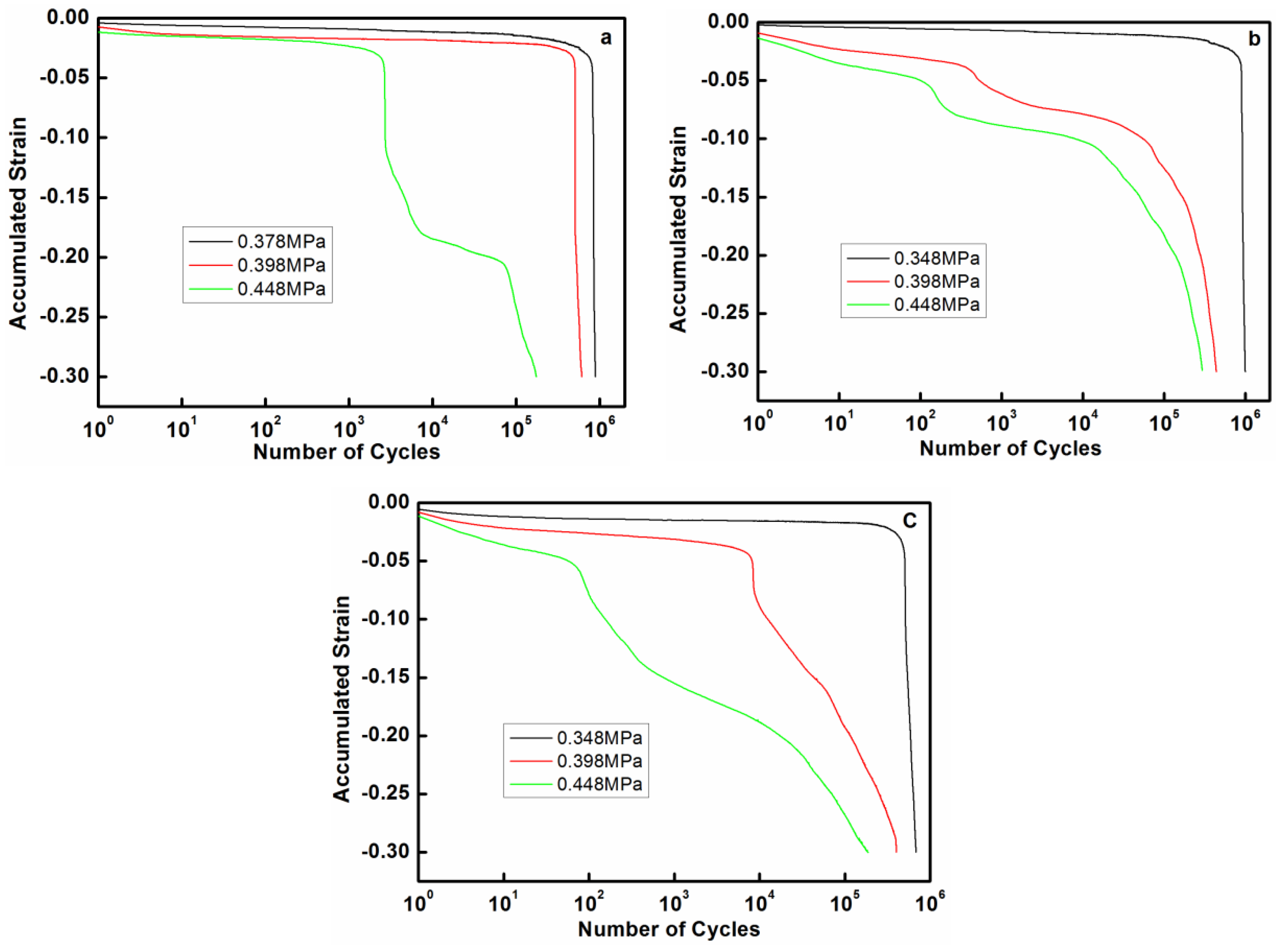
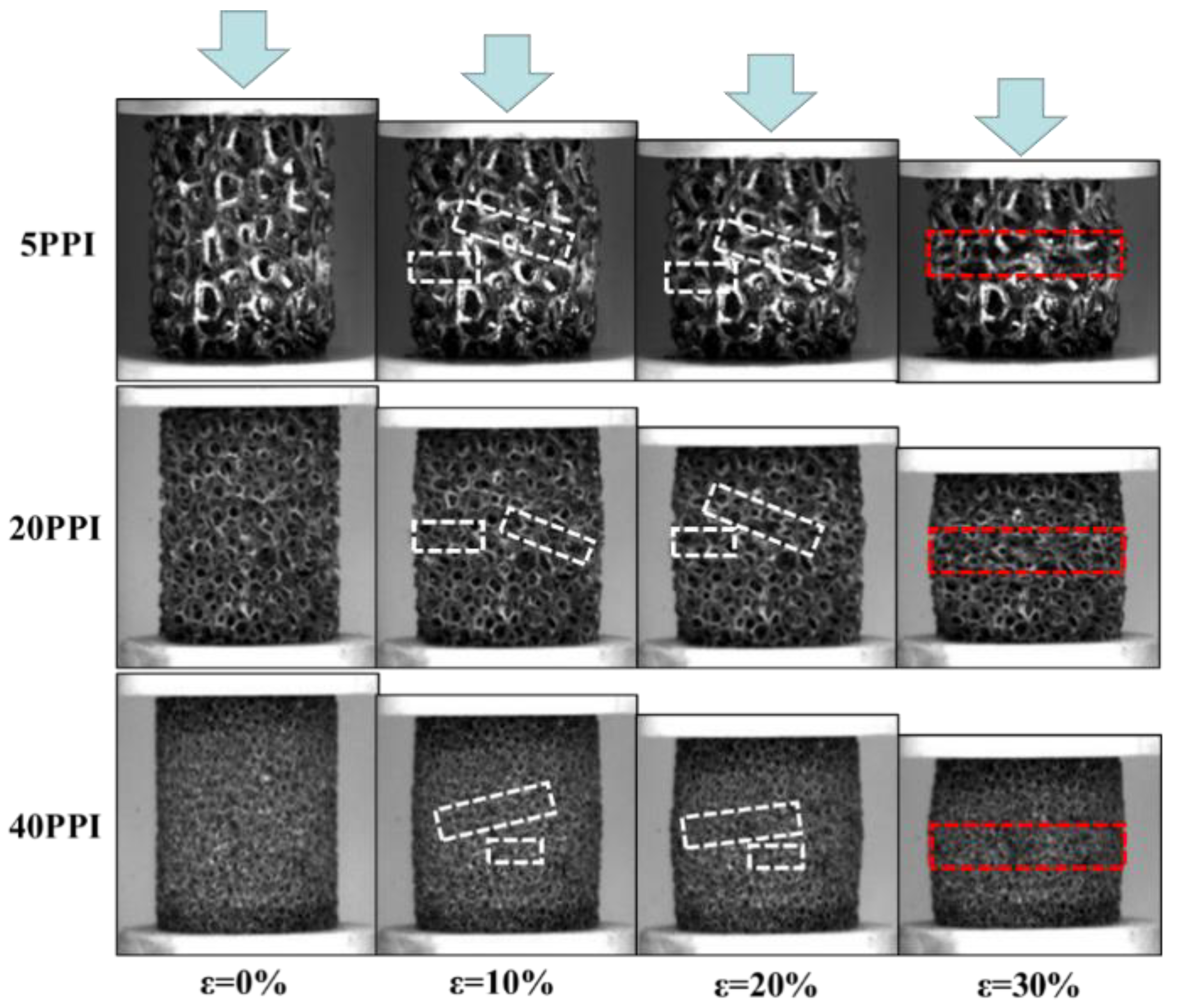
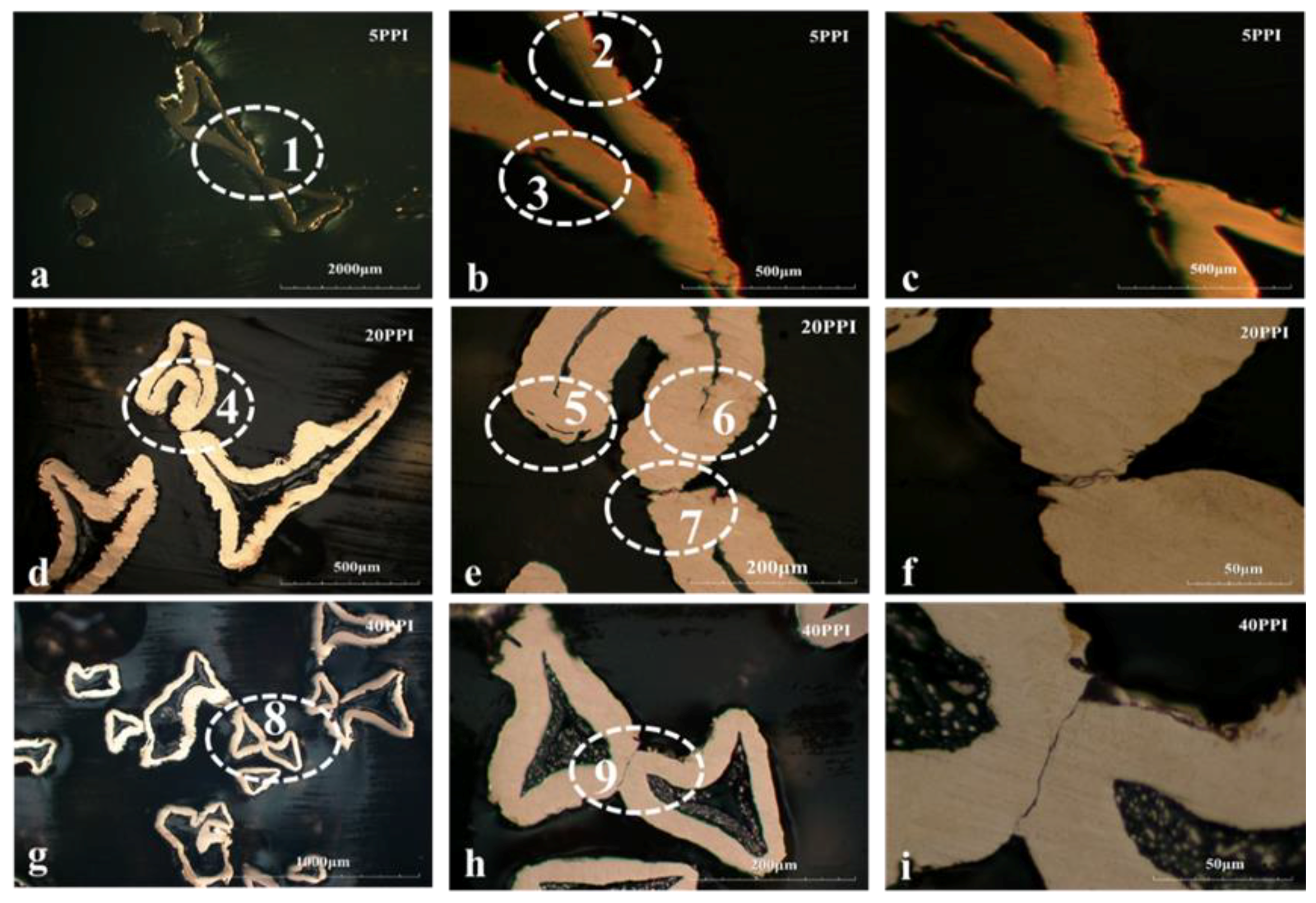
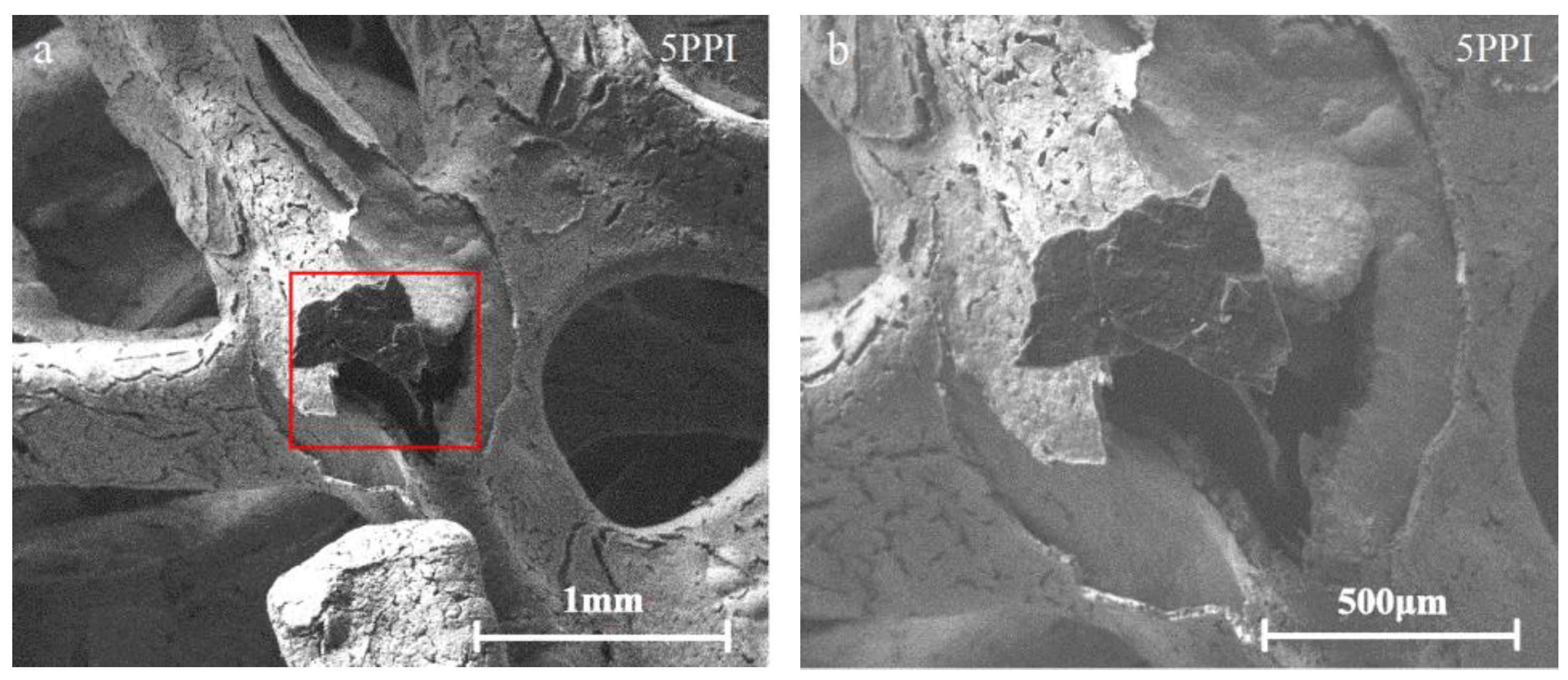
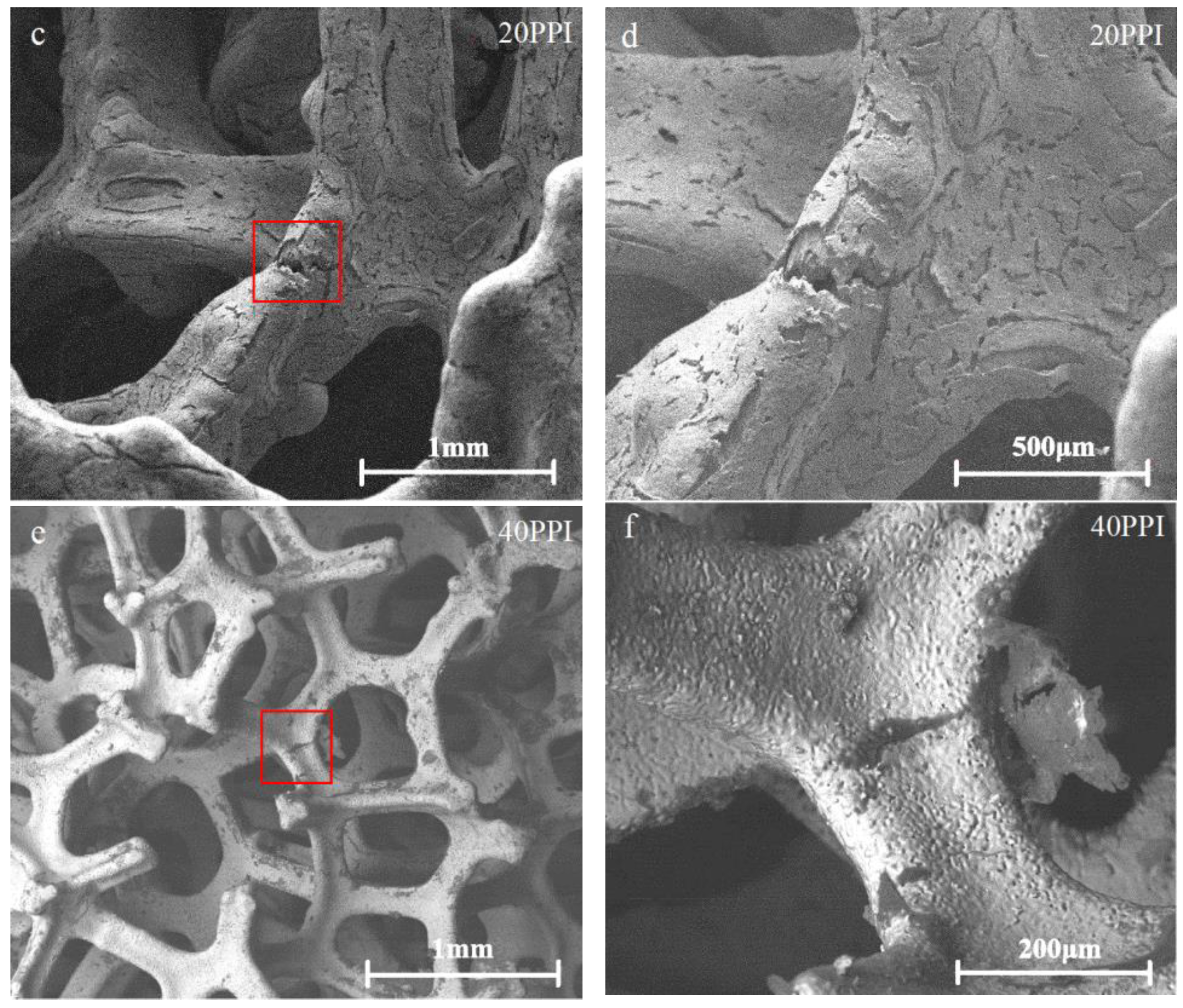

| Sample | Porosity (%) | Pore per Inch (PPI) | Relative Density (%) |
|---|---|---|---|
| 1# | 93.6 | 5 | 6.4 |
| 2# | 93.7 | 20 | 6.3 |
| 3# | 93.5 | 40 | 6.5 |
| Samples | Porosity (%) | PPI | Frequency | Stress Amplitude (MPa) |
|---|---|---|---|---|
| 1# | 93.6 | 5 | 1 Hz | 0.378 MPa 0.398 MPa 0.448 MPa |
| 2# | 93.7 | 20 | 1 Hz | 0.348 MPa 0.398 MPa 0.448 MPa |
| 3# | 93.5 | 40 | 1 Hz | 0.348 MPa 0.398 MPa 0.448 MPa |
| Strut Number | Thickness (μm) | ||
|---|---|---|---|
| 5PPI | 20PPI | 40PPI | |
| Pa 1 | 144.1 | 108.8 | 59.32 |
| Pa 2 | 115.0 | 104.8 | 68.86 |
| Pa 3 | 118.6 | 85.21 | 66.88 |
| Pa 4 | 140.1 | 93.86 | 71.22 |
| Pa 5 | 120.5 | 90.30 | 96.64 |
| Pa 6 | 101.2 | 85.03 | 76.47 |
| Average | 123.25 | 94.67 | 73.23 |
© 2018 by the authors. Licensee MDPI, Basel, Switzerland. This article is an open access article distributed under the terms and conditions of the Creative Commons Attribution (CC BY) license (http://creativecommons.org/licenses/by/4.0/).
Share and Cite
Chen, J.; Dai, S.; Li, C.; Li, W.; Ren, Y. Effects of Pore Size on Fatigue Deformation Mechanism of Open-Cell Copper Foam at Low Stress Amplitude. Materials 2018, 11, 1639. https://doi.org/10.3390/ma11091639
Chen J, Dai S, Li C, Li W, Ren Y. Effects of Pore Size on Fatigue Deformation Mechanism of Open-Cell Copper Foam at Low Stress Amplitude. Materials. 2018; 11(9):1639. https://doi.org/10.3390/ma11091639
Chicago/Turabian StyleChen, Jian, Shuowei Dai, Cong Li, Wei Li, and Yanjie Ren. 2018. "Effects of Pore Size on Fatigue Deformation Mechanism of Open-Cell Copper Foam at Low Stress Amplitude" Materials 11, no. 9: 1639. https://doi.org/10.3390/ma11091639
APA StyleChen, J., Dai, S., Li, C., Li, W., & Ren, Y. (2018). Effects of Pore Size on Fatigue Deformation Mechanism of Open-Cell Copper Foam at Low Stress Amplitude. Materials, 11(9), 1639. https://doi.org/10.3390/ma11091639




